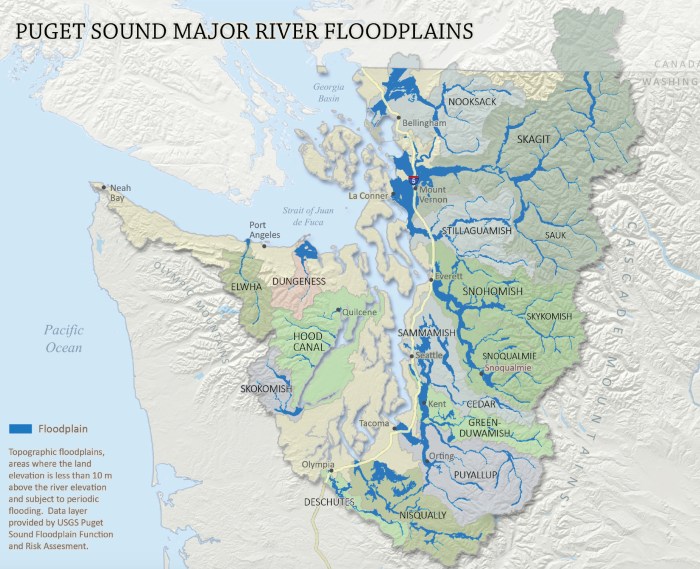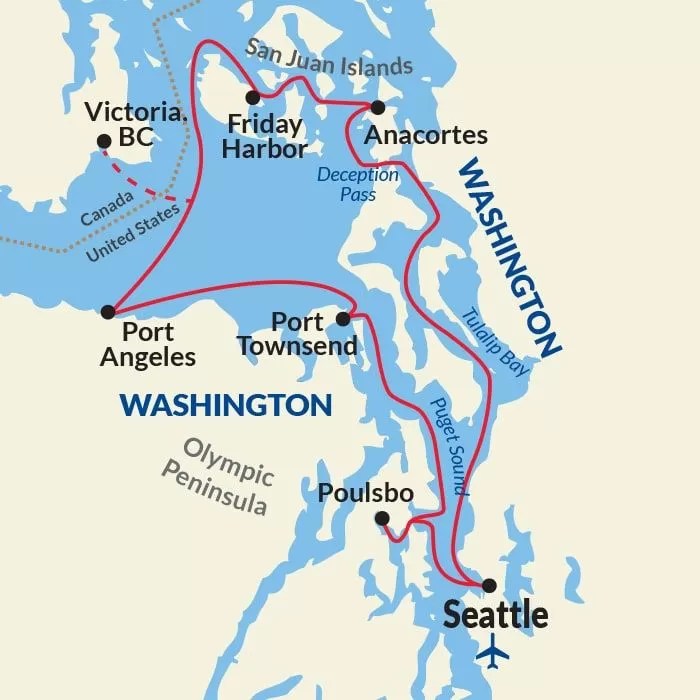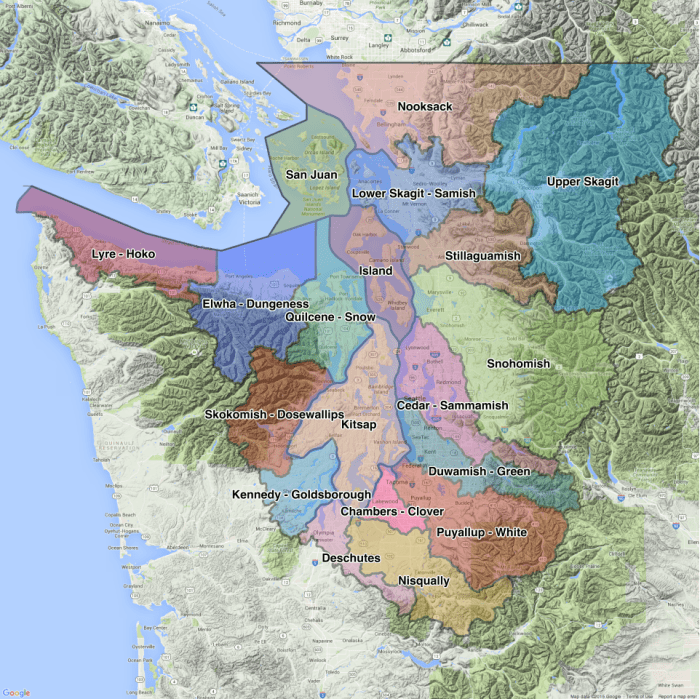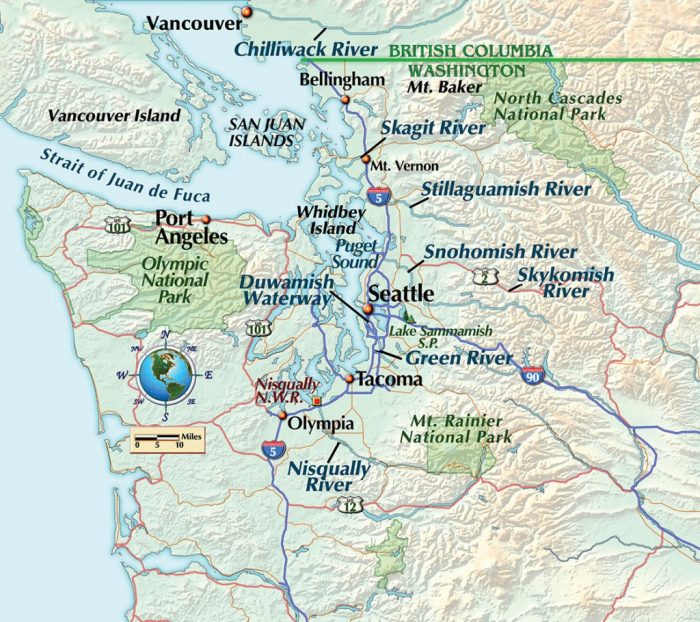Embark on an extraordinary journey through the captivating waters of Puget Sound with our comprehensive guide, “Map of Puget Sound Waterways.” This invaluable resource unveils the secrets of safe navigation, unveils hidden gems for recreation, and immerses you in the rich maritime heritage of the region.
From understanding the intricacies of tides and currents to exploring tranquil marinas and bustling harbors, our map empowers you to plan your boating adventures with confidence. Whether you seek the thrill of fishing and crabbing, the tranquility of wildlife viewing, or the exhilaration of water sports, this guide provides the essential knowledge to make your time on the water unforgettable.
Navigational Aids
Navigating the waterways of Puget Sound safely requires the use of various navigational aids. These aids provide boaters with visual cues to indicate hazards, mark channels, and guide them to their destinations.
Buoys
Buoys are floating markers that come in different shapes, colors, and sizes. They serve specific purposes, such as:
- Lateral buoys: These mark the edges of channels. Red buoys are placed on the right-hand side when entering a channel, while green buoys are on the left.
- Cardinal buoys: These indicate the four cardinal directions (north, south, east, and west) and are placed at junctions or bends in channels.
- Safe water buoys: These indicate areas that are safe for navigation.
- Danger buoys: These mark hazards such as rocks, shoals, or wrecks.
Markers
Markers are fixed structures that are placed along shorelines or in the water. They include:
- Range markers: These are pairs of markers that line up to indicate the center of a channel.
- Daybeacons: These are unlit markers that are visible during the day.
- Leading lights: These are pairs of lights that line up to indicate the center of a channel at night.
Lights
Lights are placed on buoys, markers, and other structures to provide visibility at night. They come in different colors and flashing patterns to indicate their purpose:
- Red lights: These indicate the right-hand side of a channel when entering.
- Green lights: These indicate the left-hand side of a channel when entering.
- White lights: These indicate safe water or the center of a channel.
- Flashing lights: These indicate hazards or junctions in channels.
Using navigational aids is essential for safe boating in Puget Sound. They provide boaters with the information they need to navigate safely and avoid hazards.
Tides and Currents

The Puget Sound waterways are affected by both tides and currents. Tides are the periodic rise and fall of sea levels caused by the gravitational pull of the moon and sun. Currents are the movement of water in a specific direction, caused by factors such as wind, tides, and the shape of the coastline.
Tides and currents can have a significant impact on boating activities. Boaters need to be aware of the tidal cycle and current patterns in order to plan their trips safely. Tides can affect the depth of water available for navigation, and currents can make it difficult to control a boat.
Navigating Tidal Currents
There are a few things that boaters can do to navigate safely in tidal currents:
- Be aware of the tidal cycle.Check the tide tables for the area you will be boating in to determine the times of high and low tide.
- Plan your trip accordingly.If possible, avoid boating during periods of strong currents. If you must boat during these times, be sure to take extra precautions.
- Use caution when crossing currents.Currents can be especially strong at the mouths of rivers and bays. Be sure to cross currents at a right angle to avoid being swept downstream.
- Be aware of the effects of wind on currents.Wind can increase the strength of currents, especially in shallow water. Be sure to take this into account when planning your trip.
Marinas and Harbors

Puget Sound offers a wide range of marinas and harbors that cater to various boating needs. These facilities provide a safe haven for vessels, offering amenities such as moorage, fuel, and maintenance services.
Marinas and harbors can be classified into different types, each with its own set of characteristics. Private marinas are typically owned and operated by individuals or companies, while public marinas are managed by government agencies and offer a wider range of services.
Choosing the Right Marina or Harbor
Selecting the right marina or harbor is crucial for a safe and enjoyable boating experience. Factors to consider include the size and type of your vessel, the amenities you require, and the location that best suits your boating activities.
Marina and Harbor Directory
The following table provides a list of marinas and harbors in Puget Sound, along with their location, amenities, and contact details:
| Name | Location | Amenities | Contact |
|---|---|---|---|
| Shilshole Bay Marina | Ballard, Seattle | Moorage, fuel, maintenance, showers | (206) 789-3044 |
| Elliott Bay Marina | Seattle | Moorage, fuel, laundry, restaurant | (206) 443-4444 |
| Poulsbo Marina | Poulsbo | Moorage, fuel, showers, laundry | (360) 779-4351 |
| Gig Harbor Marina & Boatyard | Gig Harbor | Moorage, fuel, maintenance, boat storage | (253) 858-0211 |
| Fauntleroy Ferry Terminal Marina | West Seattle | Moorage, fuel, ferry service | (206) 296-0082 |
Fishing and Crabbing Spots
Puget Sound is a renowned fishing and crabbing destination, offering a diverse range of species and picturesque waterways to explore. From the bustling waters of Elliott Bay to the tranquil inlets of Hood Canal, there are countless spots where anglers and crabbers can cast their lines and experience the thrill of the catch.
Popular Fishing Spots
- Elliott Bay:Known for its proximity to downtown Seattle, Elliott Bay is a popular spot for salmon, sea bass, and perch fishing.
- Shilshole Bay:Located in Ballard, Shilshole Bay is a sheltered harbor that offers excellent opportunities for catching blackmouth, chinook, and coho salmon.
- Hood Canal:This long, narrow fjord is a haven for salmon, halibut, and crab. The scenic views and abundant wildlife make it a favorite destination for recreational fishing.
Crabbing Spots
- Burrard Inlet:The shallow waters of Burrard Inlet are ideal for crabbing, particularly for Dungeness crab.
- Case Inlet:Located south of Tacoma, Case Inlet is another productive crabbing spot, known for its large populations of Dungeness and red rock crab.
- Nisqually Reach:This stretch of water between Tacoma and Olympia offers excellent crabbing opportunities, especially for Dungeness and Tanner crab.
Regulations and Techniques
Fishing and crabbing in Puget Sound are regulated by the Washington Department of Fish and Wildlife (WDFW). Anglers and crabbers must adhere to specific seasons, bag limits, and gear restrictions. It is essential to check the WDFW website for the most up-to-date regulations before heading out.
Fishing techniques vary depending on the target species. Trolling is a popular method for catching salmon, while jigging is effective for bottom-dwelling fish like lingcod and rockfish. Crabbing typically involves using baited traps or pots that are lowered to the seafloor.
Historical Sites
Puget Sound’s waterways are brimming with historical sites that narrate the region’s rich past. These sites, steeped in significance, bear witness to the vibrant maritime history, indigenous cultures, and pivotal events that have shaped the identity of the Sound.
Exploring these historical sites by boat offers a unique perspective, allowing you to traverse the same waters that once carried explorers, traders, and settlers. Whether you’re interested in military history, Native American heritage, or the rise of industry, Puget Sound’s waterways have a captivating tale to tell.
Fort Nisqually
Established in 1833 by the Hudson’s Bay Company, Fort Nisqually was a pivotal trading post and agricultural hub. Today, visitors can explore the reconstructed fort, gaining insights into the daily lives of fur traders, settlers, and the indigenous communities they interacted with.
Gig Harbor Maritime Museum
Nestled in the charming town of Gig Harbor, this museum showcases the maritime heritage of the area. Its collection includes historic boats, fishing gear, and artifacts that tell the story of the region’s shipbuilding industry, commercial fishing, and recreational boating.
Tacoma Narrows Bridge
Completed in 1950, the Tacoma Narrows Bridge stands as a testament to both engineering ingenuity and the power of nature. The original bridge famously collapsed in 1940 due to wind-induced vibrations, earning it the nickname “Galloping Gertie.” The current bridge, built with lessons learned from the collapse, is a marvel of modern engineering.
Olympia State Capitol
Perched on the shores of Budd Inlet, the Olympia State Capitol is the seat of Washington State government. Completed in 1928, this grand Beaux-Arts building houses the state legislature, governor’s office, and numerous historical artifacts.
USS Turner Joy
Moored in Bremerton, the USS Turner Joy is a retired destroyer that served in the Korean War and Vietnam War. Visitors can explore the ship’s decks, learn about its history, and gain a firsthand understanding of the sacrifices made by the men and women who served aboard her.
Wildlife Viewing: Map Of Puget Sound Waterways

Puget Sound is a haven for wildlife enthusiasts, offering ample opportunities to observe diverse marine and avian species in their natural habitat. From majestic whales to playful seals, the waterways teem with an abundance of creatures.
Observing Wildlife Responsibly
When encountering wildlife on the water, it’s crucial to respect their space and observe them responsibly. Maintain a safe distance, avoiding sudden movements or loud noises. Use binoculars or a camera with a telephoto lens to capture memories without disturbing the animals.
If you notice any signs of distress or harassment, move away promptly.
Whales
The waters of Puget Sound are frequented by several whale species, including orcas, humpback whales, and gray whales. Orcas, also known as killer whales, are often spotted near the San Juan Islands, engaging in social behaviors such as breaching and spyhopping.
Humpback whales, renowned for their acrobatic displays, can be observed breaching, slapping their tails, and performing complex bubble-net feeding techniques. Gray whales, with their distinctive mottled skin and barnacle-covered heads, are commonly seen during their annual migrations.
Seals and Sea Lions
Puget Sound is home to a variety of seal and sea lion species, including harbor seals, California sea lions, and Steller sea lions. Harbor seals are commonly found hauled out on rocks or beaches, basking in the sun or resting.
California sea lions are more playful and often seen swimming in groups, performing acrobatic leaps and dives. Steller sea lions, with their impressive size and distinctive mane, can be observed at haul-out sites or foraging for food in the water.
Birds
The Puget Sound waterways provide a rich habitat for numerous bird species, including bald eagles, great blue herons, and various seabirds. Bald eagles are frequently seen perched on snags or soaring overhead, their distinctive white heads and tails making them easily recognizable.
If you’re planning to explore the waterways of Puget Sound, having a detailed map is crucial. While there are numerous resources available, you can also check out the olivia jones vsim post quiz for additional insights and tips. Remember, having a reliable map will not only enhance your navigation but also ensure a safe and enjoyable journey through the beautiful waters of Puget Sound.
Great blue herons, with their long necks and piercing eyes, can be found wading in shallow waters, hunting for fish and other aquatic prey. Seabirds, such as cormorants, gulls, and terns, are abundant in the Sound, diving for fish and scavenging for food.
Other Wildlife
In addition to the aforementioned species, Puget Sound is home to a variety of other wildlife, including otters, porpoises, and dolphins. Otters are playful and often seen swimming, diving, and sliding on their bellies. Porpoises and dolphins, both members of the dolphin family, are known for their intelligence and social behavior, often leaping and playing in the water.
Water Sports
Puget Sound offers a vast playground for water enthusiasts, with numerous spots catering to various water sports. Whether you’re an experienced sailor or just starting to explore the joys of kayaking, the Sound has something for every skill level.
Before embarking on any water adventure, it’s crucial to prioritize safety. Wear a life jacket at all times, be aware of weather conditions, and inform someone of your plans and expected return time.
Swimming
Designated swimming areas can be found throughout Puget Sound, offering safe and enjoyable spots to cool off on hot summer days. Alki Beach in Seattle and Golden Gardens Park in Ballard are popular choices, with lifeguards on duty during peak season.
Kayaking, Map of puget sound waterways
Kayaking is an excellent way to explore the Sound’s secluded coves and islands. Several launch sites provide access to calm waters, such as Shilshole Bay Marina in Ballard and Edmonds Marina. For a more adventurous experience, consider paddling through the San Juan Islands.
Sailing
Puget Sound is a sailor’s paradise, with numerous yacht clubs and marinas offering sailing lessons and rentals. Whether you prefer a leisurely cruise or a competitive race, the Sound’s protected waters provide an ideal setting.
Boat Ramps and Launches
Boating enthusiasts will find a wide array of boat ramps and launches scattered throughout Puget Sound, providing convenient access to the water for vessels of all sizes.
Before embarking on your boating adventure, it’s crucial to select the right boat ramp or launch that aligns with your specific boating needs. Factors to consider include the size and type of your boat, the available amenities, and the proximity to your desired destination.
Types of Boat Ramps and Launches
There are various types of boat ramps and launches available in Puget Sound, each catering to different boating preferences:
- Concrete Ramps:These ramps are made of durable concrete and offer a smooth and stable surface for launching and retrieving boats.
- Gravel Ramps:Gravel ramps are more common in remote areas and provide a less expensive option. However, they may be less convenient to use, especially during low tide.
- Floating Docks:Floating docks are ideal for launching smaller boats, such as kayaks and canoes. They provide a stable platform for loading and unloading, even during changing tide levels.
Boat Ramp and Launch Amenities
In addition to the type of ramp or launch, it’s essential to consider the amenities available at each location. Common amenities include:
- Parking:Ample parking is crucial, especially for larger boats that require trailers.
- Restrooms:Restrooms are a convenient amenity, particularly for longer boating excursions.
- Fuel Docks:Fuel docks allow boaters to refuel their vessels without having to travel far.
- Fish Cleaning Stations:Fish cleaning stations provide a designated area for cleaning your catch.
Table of Boat Ramps and Launches
The following table provides a comprehensive list of boat ramps and launches in Puget Sound, along with their locations, fees, and available amenities:
| Location | Fees | Amenities |
|---|---|---|
| Shilshole Bay Marina, Seattle | $15 per day | Concrete ramp, parking, restrooms, fuel dock |
| Edmonds Marina, Edmonds | $10 per day | Gravel ramp, parking, restrooms, fish cleaning station |
| Tacoma Yacht Club, Tacoma | $20 per day | Floating dock, parking, restrooms, fuel dock, fish cleaning station |
| Gig Harbor Marina, Gig Harbor | $12 per day | Concrete ramp, parking, restrooms, fuel dock |
| Manchester State Park, Port Orchard | $10 per day | Gravel ramp, parking, restrooms, fish cleaning station |
Regulations and Safety

Navigating Puget Sound’s waterways requires adherence to specific regulations and safety measures. These regulations ensure the safety of boaters and protect the delicate marine ecosystem.
Failure to comply with these regulations can result in fines, accidents, or even legal consequences. By following these rules, boaters can contribute to a safe and enjoyable experience for all.
Licensing and Registration
- All vessels operating in Puget Sound must be registered with the Washington State Department of Licensing.
- Boaters must carry a valid boating license, which can be obtained through the same department.
Speed Limits and Navigation Rules
- Speed limits vary depending on the area and type of waterway. Boat operators must observe posted speed limits.
- Boaters must follow the “rules of the road” for navigation, including proper lighting and signaling.
Safety Equipment
- All vessels must carry required safety equipment, including life jackets, fire extinguishers, and sound-producing devices.
- Boaters should also consider carrying additional safety gear such as first-aid kits and flares.
Alcohol and Boating
- Operating a vessel under the influence of alcohol is illegal and dangerous.
- Boaters should avoid consuming alcohol before or while operating a vessel.
Wildlife Considerations
- Boaters should be aware of the presence of wildlife in Puget Sound and take precautions to avoid disturbing or harming them.
- Respect designated wildlife areas and observe speed limits in areas where marine mammals are known to frequent.
Future Developments
The Puget Sound region is constantly evolving, and there are a number of planned or proposed developments that could affect waterways. These developments include new marinas, harbors, boat ramps, and bridges. While some of these developments may benefit boaters, others could have negative impacts.One
of the most significant proposed developments is the expansion of the Port of Tacoma. This expansion would include the construction of a new container terminal and the dredging of the Blair Waterway. The expansion could have a number of impacts on boating, including increased traffic, noise, and pollution.Another
proposed development is the construction of a new bridge over the Tacoma Narrows. This bridge would replace the existing bridge, which is nearing the end of its lifespan. The new bridge would be higher and wider than the existing bridge, which would allow for larger vessels to pass through.
However, the new bridge could also have a negative impact on boating by creating a navigational hazard.Boaters should stay informed about future developments that could affect Puget Sound waterways. They can do this by reading local newspapers and websites, and by attending public meetings.
Boaters can also contact their local elected officials to express their concerns about proposed developments.
FAQ Summary
Where can I find information on boat ramps and launches in Puget Sound?
Refer to the HTML table within the “Boat Ramps and Launches” section of the guide for a comprehensive list.
What are some popular fishing spots in Puget Sound?
The “Fishing and Crabbing Spots” section highlights renowned locations for both fishing and crabbing, along with details on the types of species you can expect to catch.
How can I stay informed about future developments affecting Puget Sound waterways?
The “Future Developments” section provides insights into planned or proposed projects and their potential impacts on boating activities.